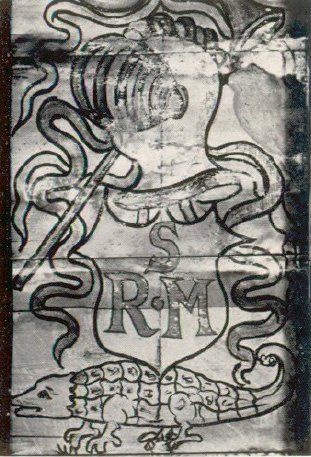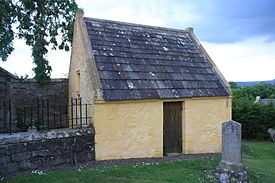The Melville's
of Rossend castle
Taken from articles written by R.M. Livingstone on Burntisland parish Church of St. Columba.
Sir Robert Melville
of Rossend Castle
Of all the famous characters who traversed the corridors and passageways of St Columba's Burntisland Kirk, few could equal in experience of international affairs that famous personality. Sir Robert Melville.
Readers of Burntisland history may often wonder exactly whom they were thinking about at times as there were two successive Sir Robert Melvilles of Burntisland Castle. Their histories seemed to overlap each other. The confusion arises from the result of the senior Sir Robert resigning his title to his son whilst both were still alive.
The person I write about here was the first Baron Melville, son of Sir John Melville. Robert was born in 1527 and died in 1621 at the ripe old age of 94.
Sir John, his father, owned Burntisland Castle around 1549. but was arrested on the sands at the Lammerlaws and executed on a trumped-up charge by Cardinal Beaton. The castle passed from the Melvilles till 1585 when Sir Robert had it restored to him by the Crown.
Sir Robert Melville received the Barony of Burntisland for his Services to the King, but for a long time he was a thorn in the side of the citizens of Burntisland.
When Melville arrived in Burntisland the people were on the point of appointing their first Town Council. One writer (Fraser) describes the Barony "as Balbie, Over Kinghorn, Welton, Orrock and Burntisland Castle, the superiority of the same and patronage of the Kirk of Kinghorn Wester".
The King could not give Sir Robert the Royal Burgh, but he gave him the office of Customs Receiver at the Port. This is confirmed by a search of the Charters at Register House. Edinburgh.
John Clephane, the first person elected Provost of the Royal Burgh had to sign Charter No. 2860 of October 21, 1586, 'which was signed by the provost, bailies and council, to Sir Robert Malvill ot Murdocarny. by which, in gratitude for his having secured ratification of their charter, they engage to aid him. his eldest son and heirs, in all just and lawful actions, to admit them as burgesses without any payment, to relieve them of all impositions levied by or upon the burgh and to allow them the first coff of all merchandise brought into the port'.
Sir Robert melville Younger
of Murdocairnie
ONE of the most dominating persons associated with St Columba's Church in its infancy was surely Sir Robert Melville, younger, who lived at Burntisland Castle.Provost of the town for many years and during the course of the building of Burntisland Kirk, he proved to be a bit of tyrant.
Sir Robert's father had three wives and he was the son of the first wife, Katherine Adamson.
Sir Robert had two wives with no surviving children. His first wife was Margaret Ker of Ferniehurst who died in May, 1594. Later he married Jean Hamilton, daughter of Gavin Hamilton of Raploch and widow of the 5th Earl of Ross. Apparently, she was a woman of some ability.
In 1606, Sir Robert had a special seat built in Burntisland Kirk for the Castle people. Two crests are painted on the panelling — that of Sir Robert Melville and that of Jean Hamilton (Lady Ross). This seat until recently was used for the "Kirkin o' the Cooncil".
THE UNWANTED PROVOST
From 1588, when he first became Provost of Burntisland, until his death in 1635, the townspeople had to suffer this man whom they did not care for very much. He was Provost from 1588 to 1598 when the people went outside the town to get someone to dislodge him.
They managed to get Sir George Home of Spot from 1599-1603 and when he withdrew, they did without a provost for one year.
However. Sir Robert was back in 1604 and 1605 but from 1606-1610 they got George, Earl of Dunbar, to fill the post.
From 1611-1617, Patrick Grieve was Provost but Sir Robert was back again, as Lord Melville by this time, from 1618 to 1630. This was too much for the people of the town and from 1630 to 1689 they carried on without a provost.
There were a number of issues between the Melville’s and the citizens of Burntisland but the main bone of contention concerned the use of the Sea Mills owned by the Castle people.
One aim was to possess the ground between the castle and the harbour so that people would be unable to gain access to the Island and the West Head.
The other was to force the inhabitants to have their meal ground and their wood sawn at the Sea Mills. The mills were driven by water wheels and tidal action and were in use till last century.

Detail showing Robert Melvilles cipher
James Melville of Halhill and heirs in Burntisland
There were four generations of men with the name James Melville, the middle two being associated with Burntisland.
Edit this text
Edit this text
Whether the above charter was nothing more or less than a piece of blackmail is a matter for conjecture but Andrew Young in his 'History of Burntisland' mentions that Melville in 1585 objected to the new Royal Charter as interfering with the bounds of the Castle.
Sir Robert Melville had a great knowledge of international intrigue and in fact was part of it most of ‘his life.
His first experience was in the service of the French, but he returned to Scotland in 1559. He opposed the marriage of Mary Queen of Scots to Lord Darnley. but when she was a prisoner at Loch Leven, he dropped a letter to her from Lethington. He was with the Queen at the Battle of Langside and later delivered to her at York, the famous casket letters, her jewels, clothing and horses.
Melville was Ambassador to England in 1582 and 1586. When in England he was sounded out by Queen Elizabeth as to the possibility of James VI succeeding her. He passed the word on to James and was rewarded by the Castle and estate at Burntisland.
It wasn't all a bed of roses for Melville, as he was declared a traitor in 1573. His forfeiture was rescinded in 1580 and he was knighted in 1581. Rapid promotion followed — Privy Councillor in 1582, appealed to Elizabeth for Mary's life, acted as Chancellor in 1589 and was sent to negotiate with Elizabeth in 1593.
By 1594 Melville was an Extraordinary Lord of Session as Lord Murdocairnie, but resigned his offices in 1600. He accompanied James VI of Scotland in 1603 when James succeeded to the English throne. Even at the age of 89 he still active and created baron Melville of Monimail in 1616. King James visited Burntisland on a few occasions and there is little doubt it was because of the proximity of the Melvilles.
He visited the Castle in 1593 and stayed for a few days. Again, at the General Assembly of the Church of Scotland in 1601 he would be in the town for about a week; this by his own choosing as the venue should have been St Andrews, but James changed it at the last minute.
When James succeeded to Elizabeth's crown it was 1617 before he came back to Scotland and one of his visiting places was Burntisland Castle.
This is not surprising as Melville, when he accompanied James to London in 1603. stayed on for a few years.
Many years ago, 1 had a search made to find out whether this gentleman had been Provost of Burntisland. A search through the Leven and Melville papers, the Register of the Great Seal, the Calendar of Charters, the Scots Peerage and many other, including Fraser's 'Melvilles. Earls of Melville', produced no evidence of this.
However, the problem was solved when the old minute books of Burntisland Town Council were found in 1957, when the elected Provost was described as Sir Robert Melville, younger.
The Sir Robert of this article never was Provost of Burntisland, but he had a great influence not only in this small town but over most of Western Europe. He lived here at the building of Burntisland Kirk in 1592-95 and was present at many of the historic happenings which took place there.
The friction with Sir Robert Melville was constant but Andrew Young in his 'History of Burntisland' wrote — "It is pleasing to record that after one of Sir Robert's attempts to encroach on their marches the Council sent asking him to allow them to meet him at the Castle gate to accompany him to the kirk. This he agreed to do."
Melville was quite a churchman and in 1633 when King Charles I was making proposals regarding the apparel of churchmen, it was an unexpected opposition on the part of Sir Robert that disconcerted the King. So much so that Charles retired to consider his position. When he did come back, he duly noted all the names of those who opposed him.
LEGACIES
Sir Robert Melville, who succeeded his father as the 2nd Lord Melville, died on 19th March, 1635, in Edinburgh and was interred at Monimail on 15th April, 1635. As his wife had died in 1631 and he had no family his relatives shared in his estate.
To Margaret Scott, widow of his wife's son James, Lord Ross, he left a plaited chain of gold with a rich jewel of diamonds; to Mrs Jean Ross, her daughter, a net chain of gold with a scarf set in pearl; to lames. Lord Ross, a purse of cloth of gold and 23 pieces of gold within it; to Robert Ross, a stand of gold buttons and another to William Ross.
Lady Raith received a jewel set with three diamonds and three pearls; Lady Halhill, a chain of gold enamelled and set with great knaps and agate with a mort head; James Melville, brother to the Laird of Raith, £1000.
The estate had been parcelled out among the Melville’s in a marriage agreement with his first wife Margaret Ker. if they died without issue.
In this agreement the lands of Wester Kinghorn (Burntisland) passed to Sir James Melville of Halhill, a cousin of the 2nd Lord Melville.
During his lifetime. Sir Robert Melville, younger, had been a of considerable importance in the life of Scotland. The Melville’s owned land and property from Midlothian to the north of Fife.
In 1587, along with his father, he resigned office as Keeper of Linlithgow Palace. In 1601 he was appointed as an extraordinary Lord of Session under the title of Lord Burntisland.
After the accession of King James to the English throne in 1603, Sir Robert was one who followed him to London and acted as one of the Scottish Privy Council there.
In 1621 he succeeded to his father's title and full possession of his estates as 2nd Lord Melville of Monimail. He had purchased Monimail Estate from Robert Balfour on 8th April. 1593.
Presumably Melville was typical of his day and age. A great churchman in his own way but he tried to be lord of all he surveyed. There were few in Burntisland to mourn his passing.


